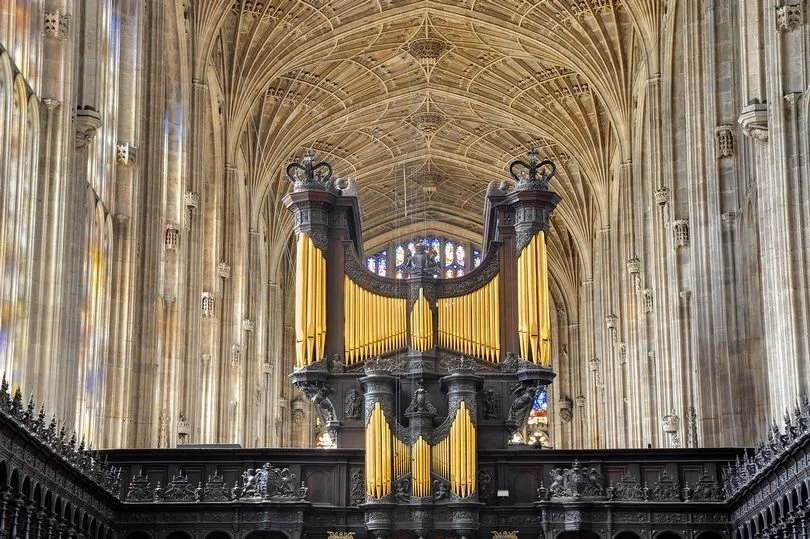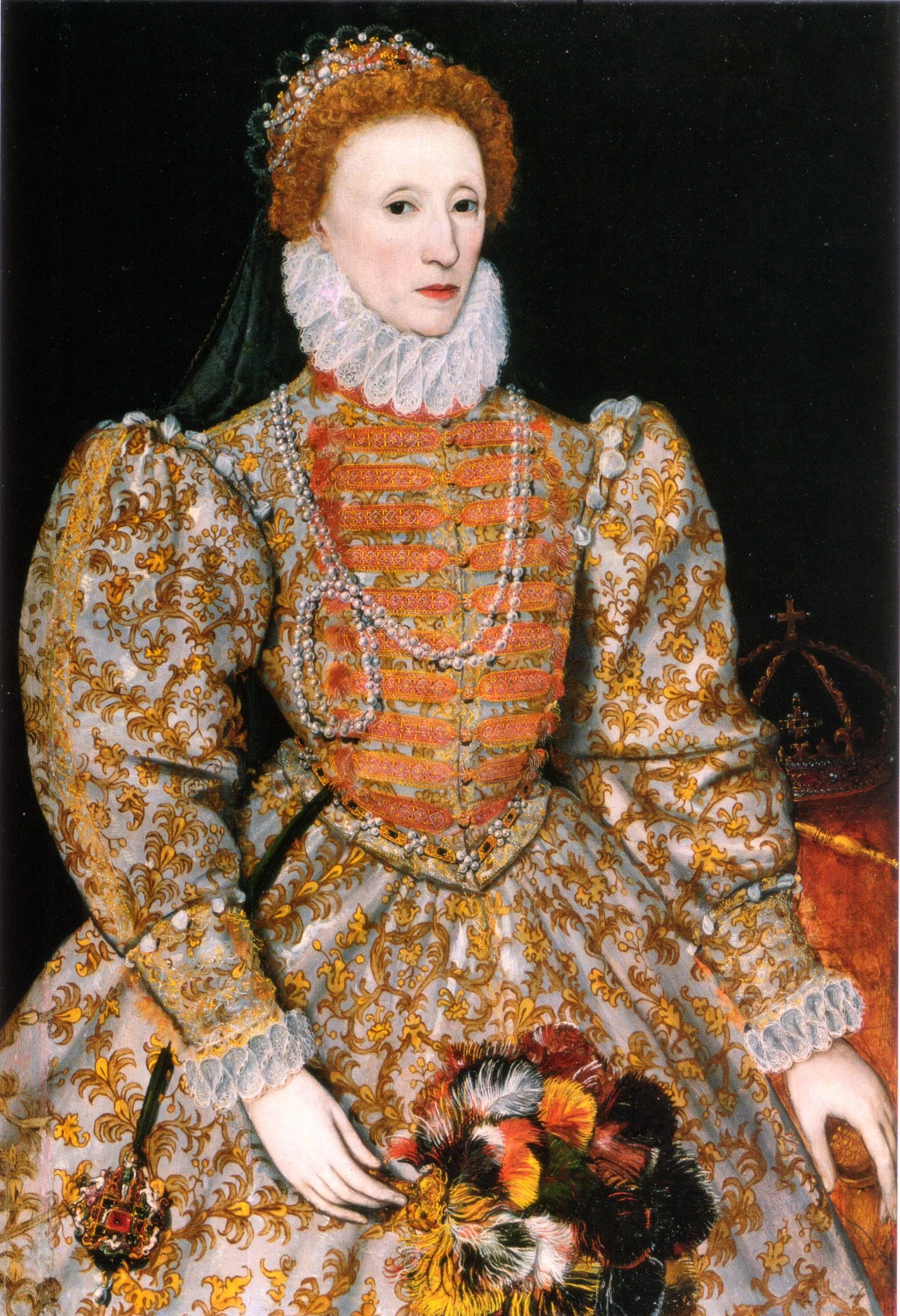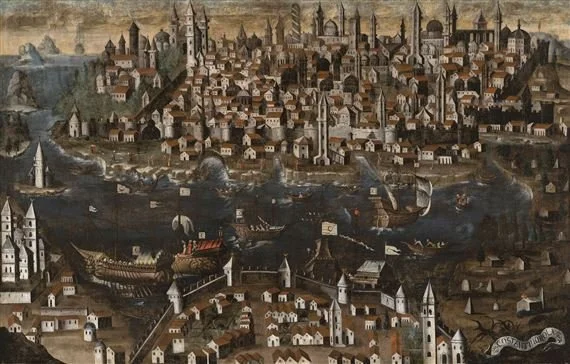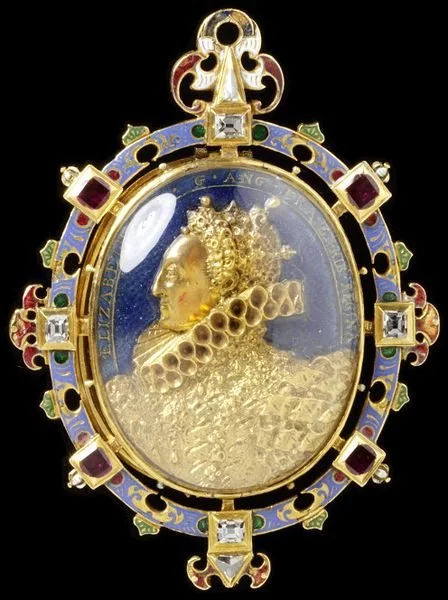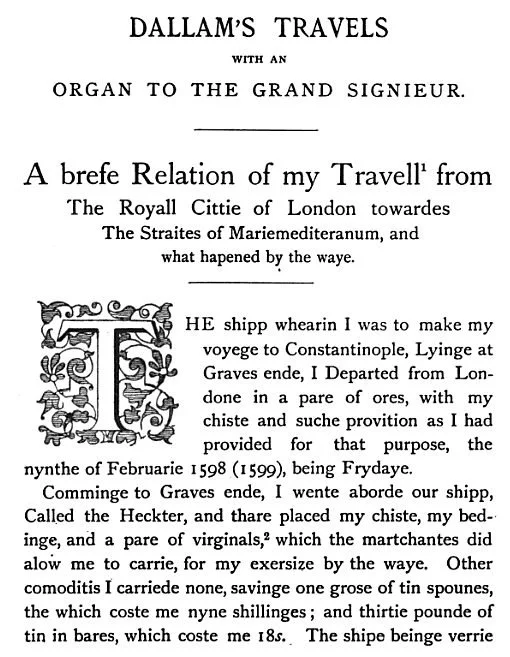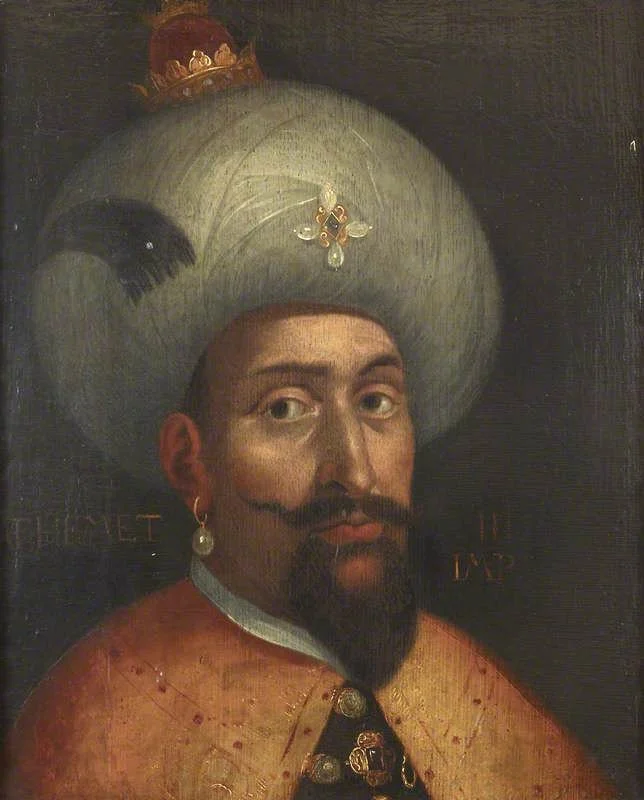The Organ that Dazzled the Grand Seigneur
Cambridge, King's College Chapel Organ, source: wikipedia
Sometime in late 1598, the British Ambassador in Constantinople, Sir Edward Barton, wrote a letter to Queen Elizabeth I, describing in detail how the Venetians were courting Sultan Mehmed III with a plethora of gifts, including a model ship that left the Grand Seigneur in awe. So weighty was the model, whose rows, poles, and cannons were made of silver and gold, that it took two strong men to carry it. Barton was unequivocal in his warning: if Her Majesty wanted the Ottomans as an ally, she had to outshine the Venetians. And that is how the idea of the Dallam's clockwork organ was born.
The "Darnley Portrait" of Elizabeth I of England, oil on panel, 113 x 78.7 cm, National Portrait Gallery, London, source: wikipedia
Artwork by Italian School, 17th century Constantinople, source: MutualArt
Royal pen pals
Left: A life-size portrait of Sultan Murad III (1574-1595) attributed to a Spanish artist, Right: The "Hardwick Hall" portrait of Elizabeth I of England, source: wikipedia
Excommunicated from the Roman Catholic Church on 25 February 1570 by Pope Pius V and consumed by a desire to challenge Habsburg hegemony in Europe, Elizabeth I never ceased to seek new ways to ensure continuous Ottoman support for her cause: she struck a trade deal with the Ottomans, initiated a letter exchange with Sultan Murad III in 1579, and appointed the first British Ambassador to Constantinople, William Harborne, in 1583. But of all her advances, the most successful was the one she made toward Safiye Sultan – favorite concubine of Murad III and mother to his successor, Mehmed III.
Left: Safiye Sultan, Right: Queen Catherine de Medici, source: wikipedia
If Her Majesty wanted the Ottomans as an ally, she had to outshine the Venetians.
In early 1593, Ambassador Barton, who by all accounts appears to be one of the most competent and intelligent diplomats of early modern European history, suggested Queen Elizabeth try and win Sultana’s heart, as to him, that seemed to be the quickest and safest way to secure the Grand Seigneur’s unwavering support. Barton was absolutely correct as Safiye Sultan, who regularly corresponded with the Venetian Ambassador to Constantinople and Queen Catherine de Medici, was one of the most influential figures in the harem, and both Murad III and his successor Mehmed III regularly took heed of her advice.
Edward Barton’s tomb in Haydarpaşa Cemetery
Sir Edward Barton was only 26 when Queen Elizabeth I appointed him as the second British Ambassador to the Ottoman Empire in 1588. Originally he took up residence at the Arap Ahmet Pasha Mansion, right outside the Genoese quarter. His endless partying and the raucous behaviour of his guests offended his Muslim neighbours, who petitioned the Imperial Council to put a stop to the Ambassador’s intemperance. So furious were the Muslim residents in the area that in an unprecedented manner, they finished the petition with a threat: “Or else, we are going to burn the house down to ashes.” So, the Council ordered the local qadi to relocate Barton to Pera, but the young Englishman refused to live amongst other Europeans and opted to take up residence in Halki, one of the Princes’ Islands, predominantly populated by the Rum (Ottoman subjects of Greek origin) at the time. Barton had a cordial relationship with Mehmed III, who ascended the throne in 1595, and accompanied the Sultan in his campaign against Hungary and was present at the Siege of Eger. Sir Edward Barton died of dysentery in 1598 and was initially buried in the Aya Panaia monastery grounds in Prinkipos, the largest of the Princes’ Islands. In 1855, his remains were moved to the Haydar Pasha Cemetery, originally established for British soldiers who fought in the Crimean War.
The Heneage Jewel, c. 1595, source: The Victoria & Albert Museum
So, “A jewel of Her Majesty’s picture, set with some rubies and diamonds,” was sent to the Harem. The gift and Elizabeth’s accompanying letter so exulted Safiye Sultan that she at once ordered the picture to be hung on one of the walls of the Harem, thereby establishing an unprecedented symbolic connection between London and Istanbul.
In return, as Muslim tradition forbade it, she could not send the Queen a portrait of her own, so she picked “a suit of princely attire in Turkish fashion.” The presence of an Ottoman royal costume in the English court in London meant the aforementioned symbolic connection was further reinforced, but that wasn’t the only gain Elizabeth secured. In her accompanying letter, Safiye Sultan wrote: “If she will never cease sending such letters which fosters the increase of sincerity and love, I shall endeavor for her aims.” Barton’s mission was an absolute success.
Dallam’s clockwork organ was not the first timepiece Britain gifted the Ottoman Empire. In 1583, Ambassador William Hareborne presented the Sultan with a square clock comprising four parts depicting different scenes: workers drawing water from a well, using a pickaxe, and pushing a wheelbarrow; dogs chasing a parcel of deer in a forest; a shepherd leading sheep to water; a cavalry of soldiers waiting for orders. Hareborne notified the Queen in a letter dated 12 May 1583 that the Sultan adored the clock.
A technological marvel
Aiming to overshadow her Venetian rivals, Elizabeth I opted for a 3-meter-high and 2-meter-wide clockwork organ built by Thomas Dallam. The giant organ provided such an awesome sight that a State Paper dated 31 January 1599 wrote: “A great and curious present is going to the Grand Turk, which will scandalize other nations, especially the Germans.”
Dallam’s Organ, Illustrated London News
The most detailed description of the organ is found in the “Relics of the Past” section of the 20 October 1860 issue of the Illustrated London News. Above the carved oak basement stood an arch panel garnished with works of gold and other rich colors. Above that were eight Corinthian pillars – of oak, carved and gilded – carrying the keyboard, which controlled the organ’s motions. Atop the keyboard was the clock and a platform – The Presence – displaying a figure of Queen Elizabeth adorned with diamonds, emeralds, and rubies, and encircled by eight other figurines. Above the platform were the royal arms with two trumpeters on each side and a head endowed with a mechanical motion to announce the hour. Finally, at the top stood a cock, with a pyramid on each side, furnished with a gilded crescent.
As an organ, it could play four or five songs “without the hand of any person on the keys for six hours without an intermission.” But, it was the nine motions it carried out as a timepiece that Dallam’s creation truly awestruck those who set eyes on it.
The clock followed the course of the sun and the moon.
An armed man placed on one of the towers struck the quarter of the hour with a loud bell.
Another armed man, placed in the second tower, struck at noon and midnight with a louder bell.
The cock, made out of metal, crowed very loudly and fluttered its wings at every hour.
The organ automatically played a chime at every hour.
Eight figures in The Presence made their obeisance to the Queen and the Queen moved her hand with the scepter to every one of them as they passed before her.
Two trumpeters lifted up and blew their trumpets as often as desired.
At the strike of every hour, the head moved, rolled its eyes, and opened its mouth.
At the strike of every hour, an angel turned the hourglass she held in her hands.
Just like his British counterpart, the Venetian Ambassador to Constantinople also kept a close tab on his rival’s movements. Soon after Dallam brought Elizabeth’s gift to Constantinople, the Ambassador wrote to the Doge in Venice: “An organ functioning like a clock, an araba (carriage) for Sultana, some silverware and fabric arrived in a majestic ship that impressed the Grand Turk.”
In Grand Seigneur’s presence
Thomas Dallam, source: alchetron.com
Dallam boarded the 300-tonne Hector in Grave’s End, Plymouth on February 9th. The organ’s disassembled parts were placed in crates and kept in the hold. The journey to Constantinople took a little more than six months, and Hector anchored in the Golden Horn on August 15th. The crates were moved to the Ambassador’s house in Galata – “among the beautiful vineyards of Pera,” wrote Dallam in his journal – on the 17th. When the embassy staff opened the crates, to his dismay, Dallam noticed that “the glowing work had all decayed because it had lied in the humid hold of the ship for more than six months” and even more worryingly, quite a few of the metal pipes were either bruised or broken. The Ambassador, convinced that the organ could not be restored to its glory, was inconsolable. But, Allam, known for his industriousness and masterful handwork, finished repairs by the 30th – “It looks as good as new,” he rightfully gloated in his journal.
Dallam’s Journal
“Whatever you do, make sure you never turn your back upon the Grand Seigneur.”
Sultan and 92. Caliph of Islam, Mehmet III of the Ottoman Empire (1566–1603), source: wikipedia
Dallam re-assembled the organ in a kiosk in Topkapı Palace sometime in mid-September and by the 24th, news reached the Ambassador that the Sultan would inspect the Queen’s gift the next day before noon. Right before he made his way to the Palace on the 25th, the Ambassador pulled Dallam to a side and gave him a stern warning: “Whatever you do, make sure you never turn your back upon the Grand Seigneur.”
Dallam was waiting outside when the Sultan entered the kiosk. After the Great Turk took his seat, “the organ began to salute its new owner”: first its bells chimed 16 times, then a song of four parts was played, followed by the two trumpeters and another song of five parts, and finally, the figurines at The Presence. The Sultan was delighted with the performance and asked Dallam to be brought in and play the keyboard. When invited by one of the guards to come and play the organ, a shiver went down Dallam’s spine. He pleaded with the guard that “he was scared to turn his back upon the Sultan'', or worse, touch him by mistake. When the guard conveyed Dallam’s fears to the Sultan, he smiled and said something back, and “with a merry countenance," the guard thrust the organ builder on.
“The Grand Seigneur gave me a thrust forward so forceful that I thought he’d been drawing his sword to cut off my head.”
Assured by the Grand Seigneur’s smile, Dallam sat on the chair and started playing the organ. The Sultan, however, was sitting right behind him and couldn’t see what the organ builder was doing, so he asked his guard to move his chair to one side. As Mehmed III stood up from his chair, “The Grand Seigneur gave me a thrust forward so forceful that I thought he’d been drawing his sword to cut off my head.” Lucky for Dallam, what hit him was only the arm of the Sultan, who was so pleased with what he had seen that he awarded the Englishman with 45 pieces of gold.
Epilogue
Mehmed III asked Dallam to remain in Constantinople and his service but the organ builder lied and told him he had a wife and children waiting for him back in London.
Portrait of Ahmed I, Sultan of the Ottoman Empire (1603-1617). The portrait has been printed using the Giclée process, source: wikipedia
Unbeknownst to himself, Dallam had made the most crucial decision of his life as, unlike Mehmed III, who spent hours on end listening to and playing with the organ, his successor Ahmed I was a religious zealot who approached everything Western with suspicion
According to historian Mustafa Safi, one day the Sultan destroyed the organ with a halberd and ordered its pieces to be burnt to ashes, leaving little to the imagination what would have befallen its creator had he been there.
Further readings
The Diary of Master Thomas Dallam, 1599-1600. London: Hakluyt Society, 1893.

